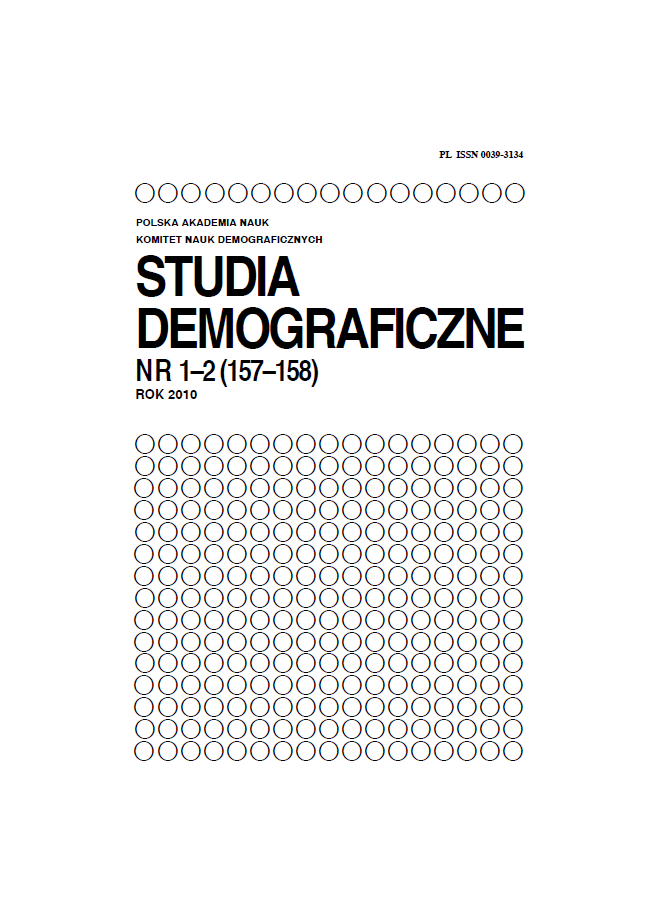Validation of data quality from Polish Fertility Survey 2002 with use of cohort fertility rates
Main Article Content
Abstract
The paper validates data from the Fertility Survey 2002 in order to establish their comparability with selected variables from the National Census and cohort fertility trends calculated with use of the birth register database. In the fi rst part of the analysis, we compare distributions of residence, age and educational level from the Fertility Survey and the National Census in order to measure the sampling bias. The second part of the analysis compares cohort fertility rates based on the Fertility Survey and registration of births. In this part, both weighted and nonweighted Fertility Survey data were used in order to account for biases from the cohort fertility based on registration data. We conclude that the distribution of selected variables obtained from the Fertility Survey sample signifi cantly deviates from the respective distribution from the National Census. This bias infl uences cohort fertility rates calculated using Fertility Survey data, which tend to overestimate cohort fertility rates observed in the population. Application of inverse probability weights removes the bias in the sample structure but does not entirely remove overestimation of cohort fertility rates. We also conclude that the remaining difference in cohort fertility results from other sources of bias which we cannot control for. However, the magnitude of bias should not have an impact on the results of statistical modeling with use of Fertility Survey data.
Article Details
References
[2] Hayford S.R., P. Morgan, 2008, The Quality of Retrospective Data on Cohabitation, „Demography” 45(1): 129-141 .
[3] Holzer J.Z., D. Holzer-Żelażewska, 1997, Płodność kohortowa kobiet w Polsce w latach 1945-1994, (Cohort Fertility of Polish Women, 1945-1994), „Studia Demograficzne” 2: 3-23.
[4] Holzer-Żelażewska D., K. Tymicki, 2009, Cohort and Period Fertility of Polish Women, 1945-2008, “Studia Demografi czne”, no. 1: 48-69
[5] Kreyenfeld, Michaela, Anne Hornung, Karolin Kubisch, and Ina Jaschinski, 2010, Fertility and Union Histories From German GGS Data: Some Critical Refl ections. MPIDR Working Paper 2010-023. Max Planck Institute for Demographic Research, Rostock; http://www.demogr.mpg.de.
[6] Murphy M., 2009, Where Have All the Children Gone? Women’s Reports of More Childlessness at Older Ages Than When They Were Younger in a Large-Scale Continuous Household Survey in Britain, “Population Studies” 63(2): 115-133 .
[7] Paradysz J., 1989, O błędach nielosowych w badaniu dzietności kobiet w ramach Narodowego Spisu Powszechnego 1970, [w:] Problemy badań statystycznych metodą reprezentacyjną, Główny Urząd Statystyczny, Warszawa, Biblioteka Wiadomości Statystycznych t. 36: 154-159.
[8] Paradysz J., 1992, Dzietność kobiet w Polsce, Główny Urząd Statystyczny, Warszawa.
[9] Paradysz J., 2000, Rekonstrukcja dzietności małżeńskiej kobiet w późniejszym wieku na podstawie ankiety retrospektywnej, Studia Demografi czne, nr 1, 1999: 13 - 34.
[10] Paradysz J., 2002, Badanie małżeńskości i dzietności kobiet w narodowych spisach powszechnych, Wiadomości Statystyczne nr 1, 2002: 77- 87.
[11] Rendall M.S., L. Clarke, E.H. Peters, N. Ranjit, G. Verropoulou, 1999, Incomplete Reporting of Men’s Fertility in the United States and Britain: A Research Note, „Demography” 36(1): 135-144.
[12] Weisberg H. F., 2005, The Total Survey Error Approach, Chicago: University of Chicago Press.
